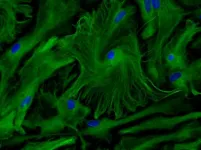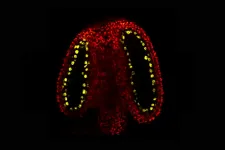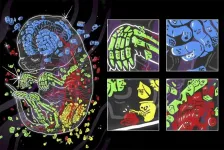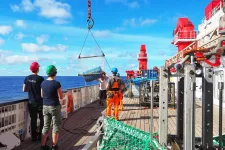(Press-News.org) As smart watches are increasingly able to monitor the vital signs of health, including what's going on when we sleep, a problem has emerged: those wearable, wireless devices are often disconnected from our body overnight, being charged at the bedside.
"Quality of sleep and its patterns contain a lot of important information about patients' health conditions," says Sunghoon Ivan Lee, assistant professor in the University of Massachusetts Amherst College of Information and Computer Sciences and director of the Advanced Human Health Analytics Laboratory.
But that information can't be tracked on smartwatches if the wearable devices are being charged as users sleep, which prior research has shown is frequently the case. Lee adds, "The main reason users discontinue the long-term use of wearable devices is because they have to frequently charge the on-device battery."
Pondering this problem, Lee brainstormed with UMass Amherst wearable computing engineer Jeremy Gummeson to find a solution to continuously recharge these devices on the body so they can monitor the user's health 24/7.
The scientists' aha moment came when they realized "human skin is a conductible material," Lee recalls. "Why can't we instrument daily objects, such as the office desk, chair and car steering wheel, so they can seamlessly transfer power through human skin to charge up a watch or any wearable sensor while the users interact with them? Like, using human skin as a wire.
"Then we can motivate people to do things like sleep tracking because they never have to take their watch off to charge it," he adds.
In a paper published in the Proceedings of the ACM on Interactive Mobile, Wearable and Ubiquitous Technologies, Lee, Gummeson and lead author Noor Mohammed, a Ph.D. student in Lee's lab, lay out the technical groundwork and showcase its feasibility. "I am hopeful that this will open a lot of possibilities toward the development of battery-less wearable devices both for consumer and clinical applications," Mohammed says.
This week, the UMass Amherst team received a $598,720 grant from the National Science Foundation to continue to develop the system's hardware and software.
Gummeson, an assistant professor of electrical and computer engineering, explains how the technology uses human tissue as a transfer medium for power. "In this device we have an electrode that couples to the human body, which you could think of as the red wire, if you're thinking of a traditional battery with a pair of red and black wires," he says.
The conventional black wire is established between two metal plates that are embedded on the wearable device and an instrumented everyday object, which becomes coupled (or virtually connected) via the surrounding environment when the frequency of the energy carrier signal is sufficiently high - in the hundreds of megahertz (MHz) range.
The researchers tested a prototype of their technology with 10 people in three scenarios during which the individuals' arm or hand made contact with the power transmitter - either as they worked on a desktop keyboard or a laptop, or as they were holding the steering wheel of a car.
Their research showed that approximately 0.5 - 1 milliwatt (mW) of direct current (DC) power was transferred to the wrist-worn device using the skin as the transfer medium. This small amount of electricity conforms to safety regulations established by the International Commission on Non-Ionizing Radiation Protection (ICNIRP) and Federal Communications Commission (FCC).
"You can think of the amount of power that gets transmitted by our technology as roughly comparable to what's transmitted through the human body when you stand on a body composition scale, hence poses minimal health risks," Gummeson says.
There is no sensation to the person who comes into contact with the power transmitter. "This is way beyond the frequency range that the human can actually perceive," Lee says.
The prototype currently doesn't produce enough power to continuously operate a sophisticated device such as an Apple Watch but could support ultra-low-power fitness trackers like Fitbit Flex and Xiaomi Mi-Bands.
The UMass Amherst team aims to improve the power transfer rate in subsequent studies and says smart wearable devices also will become more power-efficient as technologies advance. "We imagine in the future as we further optimize the power that's consumed by the wearable sensors, we could reduce and ultimately eliminate the charging time," Gummeson says.
Lee adds, "We think this is an innovative solution."
INFORMATION:
Related video: https://www.youtube.com/watch?v=zrJwZRauO4E
Over years of studying antibody responses against the flu in the Wilson lab at the University of Chicago, researchers kept coming up with a strange finding: antibodies that seemed to bind not only to the flu virus, but to every virus the lab could throw at them. Since antibodies are usually highly specific to individual pathogens, in order to maximize their targeted protective response, this pattern was extremely unusual.
Until finally, they realized: The antibodies weren't responding to the viruses, but rather to something in the biological material in which the viruses had been grown. ...
Astrocytes are cells in the brain which have long been considered only as mere support cells for neurons. In recent years, the study of astrocytes has grown, gradually revealing their importance in brain function. Researchers from Inserm, CNRS and Collège de France at the Center for Interdisciplinary Research in Biology have now uncovered their crucial role in closing the period of brain plasticity that follows birth, finding them to be key to the development of sensory and cognitive faculties. Over the longer term, these findings will make it possible to envisage new strategies for reintroducing brain plasticity in adults, thereby promoting rehabilitation following brain lesions or neurodevelopmental disorders. This research has been published in Science.
Brain plasticity is ...
Hereditary information is passed from parent to offspring in the genetic code, DNA, and epigenetically through chemically induced modifications around the DNA.
New research from the John Innes Centre has uncovered a mechanism which adjusts these modifications, altering the way information beyond the genetic code is passed down the generations.
DNA methylation, one example of these epigenetic modifications, happens when a methyl group or chemical cap is added to the DNA, switching a gene, or genes, on or off.
As germline (eggs and sperm) cells develop some of the methyl markers are reset, affecting the information passed onto the next generation.
How this process ...
Although plastics have become an essential material, permeating almost all aspects of modern living, many of the inherent properties that make them useful in such a wide variety of applications also make them a serious environmental threat. In a special issue of Science, "Our Plastics Dilemma," four Reviews, two Perspectives, a Policy Forum, an associated Report and two News features examine a wide range of topics related to plastics and the problems they present. "As for much new technology, their development and proliferation occurred with little consideration for their impacts, but now it's impossible to deny their dark side as we confront a rapidly ...
Through the sequencing of more than 640,000 human exomes, researchers identify rare gene coding variants strongly associated with body mass index (BMI) - including the variant GPR75, which conferred protection from obesity in mouse models. Not only do the findings provide potential therapeutic targets for treating obesity, but they also demonstrate the power and versatility of massive-scale exome sequencing in discovering rare coding variants that could offer new and potentially translatable biological functions. Body fat is a highly heritable trait and the obesity to which body ...
Researchers could not confirm that a feature that supposedly signals the presence of Majorana bound states - the unusual quasiparticles that may become the cornerstone of topological quantum computing - was in fact due to elusive Majorana particles, in full-shell semiconductor/superconductor nanowires. Rather, this feature, known as zero bias conductance peak, can arise from another quantum phenomenon in these hybrid nanowire structures, the authors say. In recent years, intense research has been conducted on nanowire-based semiconductor-superconductor hybrid systems because predictions suggest that a topological superconductor state with Majorana zero modes (MZMs) can be engineered from them. Even though several experiments in such platforms have reported ...
Researchers introduce "sci-Space," a new approach to spatial transcriptomics that can retain single-cell resolution and spatial heterogeneity at scales much larger than previous methods. They used their approach to build single-cell atlases of whole sections of mouse embryos at 14 days of development. Single-cell RNA sequencing methods have led to great advances in understanding how organisms and complex tissues develop. Although cells' spatial organization is central to normal development, homeostasis, and pathophysiology, many single-cell RNA sequencing methods lose valuable contextual spatial information. Those that preserve spatial context between cells can be limited to a specific set of genes and/or ...
A new technique called sci-Space, combined with data from other technologies, could lead to four-dimensional atlases of gene expression across diverse cells during embryonic development of mammals.
Such atlases would map how the gene transcripts in individual cells reflect the passage of time, cell lineages, cell migration, and location on the developing embryo. They would also help illuminate the spatial regulation of gene expression.
Mammalian embryonic development is a remarkable phenomenon: a fertilized egg divides repeatedly and turns, in a matter of weeks or months, into a complex organism capable of a myriad of physiological processes and composed of a variety ...
Quantum computers promise great advances in many fields - from cryptography to the simulation of protein folding. Yet, which physical system works best to build the underlying quantum bits is still an open question. Unlike regular bits in your computer, these so-called qubits cannot only take the values 0 and 1, but also mixtures of the two. While this potentially makes them very useful, they also become very unstable.
One approach to solve this problem bets on topological qubits that encode the information in their spatial arrangement. That could provide a more stable ...
Current rates of plastic emissions globally may trigger effects that we will not be able to reverse, argues a new study by researchers from Sweden, Norway and Germany published on July 2nd in Science. According to the authors, plastic pollution is a global threat, and actions to drastically reduce emissions of plastic to the environment are "the rational policy response".
Plastic is found everywhere on the planet: from deserts and mountaintops to deep oceans and Arctic snow. As of 2016, estimates of global emissions of plastic to the world's lakes, rivers and ...





